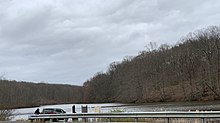| Rocky Brook | |
|---|---|
 Map of Rocky Brook | |
| Location | |
| Country | United States |
| Physical characteristics | |
| Source | |
| • coordinates | 40°13′8″N 74°24′37″W / 40.21889°N 74.41028°W |
| Mouth | |
• coordinates | 40°17′18″N 74°32′23″W / 40.28833°N 74.53972°W |
• elevation | 79 ft (24 m) |
| Basin features | |
| Progression | Millstone River, Raritan River, Atlantic Ocean |
| River system | Raritan River system |
| Tributaries | |
| • right | Timber Run |
Rocky Brook is a tributary of the Millstone River in Monmouth and Mercer counties, New Jersey, in the United States.[1]
Course
[edit]
Rocky Brook starts at 40°13′8″N 74°24′37″W / 40.21889°N 74.41028°W,[2] near Perrineville. It flows parallel to CR-1 (Sweetmans Lane) before draining into Perrineville Lake. It continues flowing west into the northern areas of Perrineville Lake Park. It then turns northwest and crosses Perrineville Road and flows through the Etra Road Open Space area. It crosses Disbrow Hill Road and drains into the Etra Lake at 40°15′13″N 74°29′59″W / 40.25361°N 74.49972°W.[2]

It continues flowing west alongside Etra Road and crosses the New Jersey Turnpike. It then flows into Peddie Lake in the heart of Hightstown. It crosses Route 33 and flows past the Town Center Plaza and Shopping Center before crossing Route 130 and the Hightstown Bypass. It then flows alongside the East Windsor Open Space Acquisition before draining into the Millstone River at 40°17′18″N 74°32′23″W / 40.28833°N 74.53972°W.[2]
Tributaries
[edit]Lakes
[edit]There are several lakes that flow along the course of the brook. These include:
- Perrineville Lake in Millstone
- Etra Lake in East Windsor
- Peddie Lake in Hightstown (in which it receives its namesake from the nearby Peddie School)

Sister tributaries
[edit]Rocky Brook's sister tributaries include:
- Beden Brook
- Bear Brook
- Cranbury Brook
- Devils Brook
- Harrys Brook
- Heathcote Brook
- Indian Run Brook
- Little Bear Brook
- Millstone Brook
- Peace Brook
- Royce Brook
- Simonson Brook
- Six Mile Run
- Stony Brook
- Ten Mile Run
- Van Horn Brook
See also
[edit]References
[edit]External links
[edit]
Well, that’s interesting to know that Psilotum nudum are known as whisk ferns. Psilotum nudum is the commoner species of the two. While the P. flaccidum is a rare species and is found in the tropical islands. Both the species are usually epiphytic in habit and grow upon tree ferns. These species may also be terrestrial and grow in humus or in the crevices of the rocks.
View the detailed Guide of Psilotum nudum: Detailed Study Of Psilotum Nudum (Whisk Fern), Classification, Anatomy, Reproduction